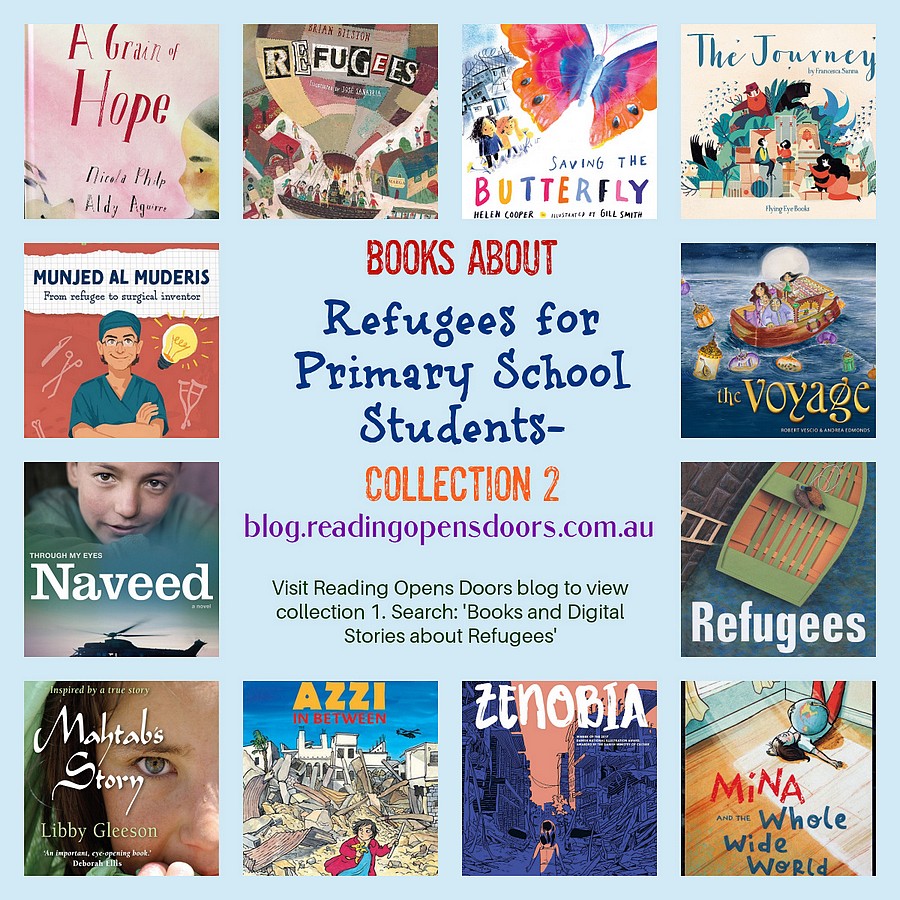
To see collection 1 containing books and digital stories about refugees click here.
Hearing stories about refugees allows children to learn about the reasons why people make the agonising choice to flee their countries and put themselves in life threatening situations in a desperate attempt to seek safety. These stories are gateways to important conversations, they have the power to dismantle bias and encourage empathy and inclusiveness.
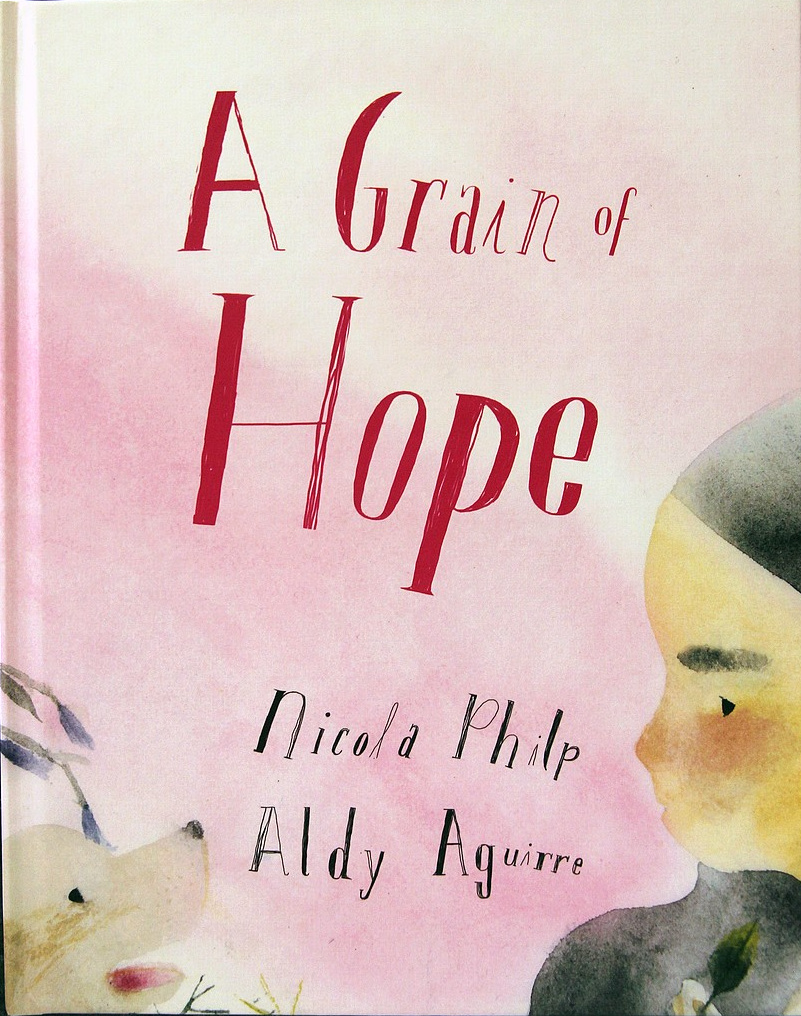
A Grain of Hope by Nicola Philp and illustrated by Aldy Aguirre is an important story about asylum seekers and detention in Australia. Nicola Philp’s inspiration to write this story was driven by several influences including her penpal on Manus Island. Another motivation for writing this story was in response to a comment Nicola heard at a ‘Festival of Hope’ about refugees where Human Rights lawyer, Julian Burnside QC said “in Australia we treat animals better than we do refugees”. Most of all, Nicola wrote this story because she believes in Human Rights and speaking out for those who can’t.
This book follows two stories and begins with the story of a newborn puppy (this story is told on the pages on the left) and the other story follows a child who is born on the other side of the world (her story is told on the pages on the right). This is a story about how the circumstances in their lives lead to change.
A detailed review has been written in an earlier Reading Opens Doors blog post here
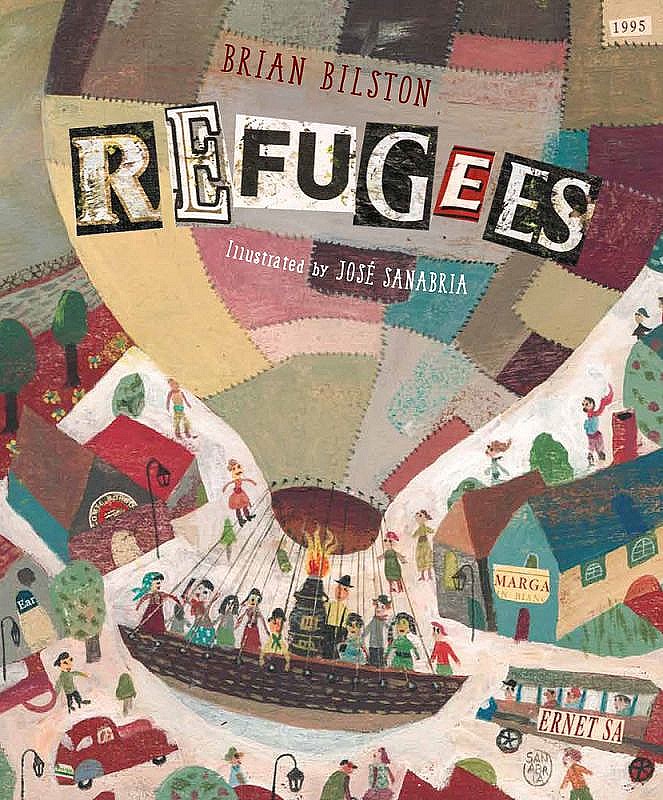
Refugees by Brian Bilston and illustrated by José Sanabria is a picture book containing Brian Bilston’s powerful poem, titled, ‘Refugees’, which can be read from top to bottom and then read backwards, from the last line to the top of the poem to convey two opposing points of view about refugees. It contains two voices. One view is prejudiced against refugees, full of hatred and intolerance, not willing to welcome people fleeing their countries, their homes, in sheer desperation because of war, famine, slavery, intolerance, economic and political upheaval, often in harrowing conditions fraught with danger and the real possibility they may pay the ultimate price, their lives. This agonising decision is made in the hope that those seeking refuge may have the opportunity to live in peace and safety. The opposing voice is rooted in compassion, empathy, tolerance and understanding. This book is structured in a way that the first half of the book is written (with all of the text presented on the left pages) so that the reader reads the poem from the first line through to the end of the twenty-four line poem. In the second half of the book, the text (written on the page on the right) is written starting with the last line of the poem through to the first.
A detailed review has been written in an earlier Reading Opens Doors blog post here

Saving the Butterfly by Helen Cooper and illustrated by Gill Smith sensitively explores, through the eyes of two children, the different responses and emotions refugee children may experience as well as the trauma and barriers they endure when seeking safety in their new homeland.
In this picture book a brother and sister are the only survivors on a boat of refugees. The older sister doubted they would survive. From the moment they are rescued they have different reactions and emotions to their lived experiences. The older sister immediately takes on an adult role and all of the responsibilities that come with this. This in effect shields her younger brother from their grim reality. The younger brother considers them to be fortunate, the older sister doesn’t see their story with this optimism. Her mind is flooded with and haunted by the memories. Her younger brother not burdened by memories of their home and loss, makes friends in this new homeland and enjoys good mental health, while his sister becomes more and more withdrawn, rarely leaving their broken home.
The younger brother feels helpless and powerless to support his big sister. As the older sister becomes house bound the younger brother comes up with the idea to bring part of the outside inside to her. He captures a butterfly. The butterfly seems in tune with the older sister’s pain and settles ever so gently on her hand. She is able to focus on the glorious colours and beauty of the butterfly, a time of beauty, light and a glimmer of hope in her otherwise dark and heavy days. Could this trapped butterfly, fragile and needing to be set free, mark the beginning of her healing?
A detailed review has been written in an earlier Reading Opens Doors blog post here.

The Journey by Francesca Sanna is a picture book inspired by interviews the author had with many people who had left their homeland. This book tells the story of many who leave behind all that they know and love and make the perilous journey, fraught with danger and no guarantees. The story where people have no choice but to be courageous in such harrowing circumstances and display immense human strength as they endure unimaginable fear and loss in an attempt to defy the odds.
This story, narrated by a young child explaining her family’s circumstances in an unspecified location, begins with a day at the beach and how this once treasured place is a destination they no longer visit as their lives have irrevocably changed. A war has started and plunges everything into a state of chaos. First the war claims their father, then their home as the children’s mother makes the agonising decision to flee to another country. Suitcases are packed and the physical journey of moving begins. The mother tells her children it will be “a great adventure”. They use different modes of transport and each one demands less luggage on board, so the further they travel, the more of their possessions they sacrifice. After days of gruelling travelling they arrive at the border only to be confronted by a guard who refuses them entry. With no choice, they sleep in the forest only to be woken by more guards. They are on the run again. They meet an unfamiliar man, money is exchanged in return for this man to take the mother and children over the border. The journey continues as the family must cross the ocean. They board an overcrowded boat and endure an arduous journey. More turmoil. Storytelling brings them comfort and hope. Once they disembark there is still more of the journey to be had, this time a train takes them over more borders. The child sees birds flying above the train and hopes that just as the birds are migrating, she will find a new home just like them and start a new story. Their journey has not ended.
The restricted colour palette is contrasted with black menacing shapes that have an anthromorphic quality to them with what appears to be claws at the end reaching out towards the family, representing the threatening, looming and ever present danger of war. As hope fills the family the use of these black shapes is reduced. Also in the illustrations the astute reader will notice the birds migrating and draw parallels between this and the family leaving their home in search of a new one.
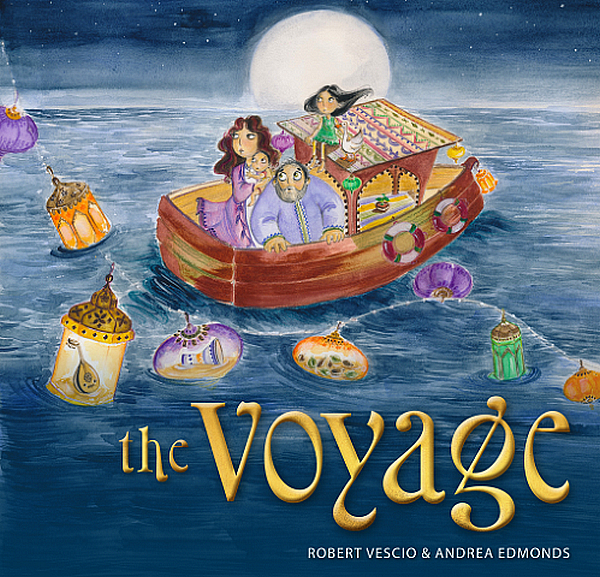
Voyage by Robert Vescio and illustrated by Andrea Edmonds is a unique picture book and a story that is different to many of the other books about refugees that I have seen. This powerful story is told with fourteen words coupled with evocative double page spread illustrations (one word per double page spread). These fourteen words tell the story of one family forced to flee their homeland because of war and conflict; the “chaos” that ensues as people are seen running away from burning buildings with smoke billowing into the sky, fleeing with few if any possessions, frantic to find safety. This family together with their pet duck, make the perilous journey across the unforgiving ocean to eventually find a land where they are “safe”.
The fourteen words and illustrations deftly highlight not only the physical journey but the emotional journey; the unfathomable fear, uncertainty, loss and the sheer tenacity required to endure such a treacherous journey clinging to hope against all odds.
The impactful illustrations while depicting harrowing circumstances are sensitively rendered. They have a gently quality about them and have been created with watercolour and pencil while employing a soft colour palette. This is very much a visually driven story.
This is an invaluable book to share with children as there is plenty of scope for readers to reflect and add their own words to this story which helps build empathy and understanding about refugees.
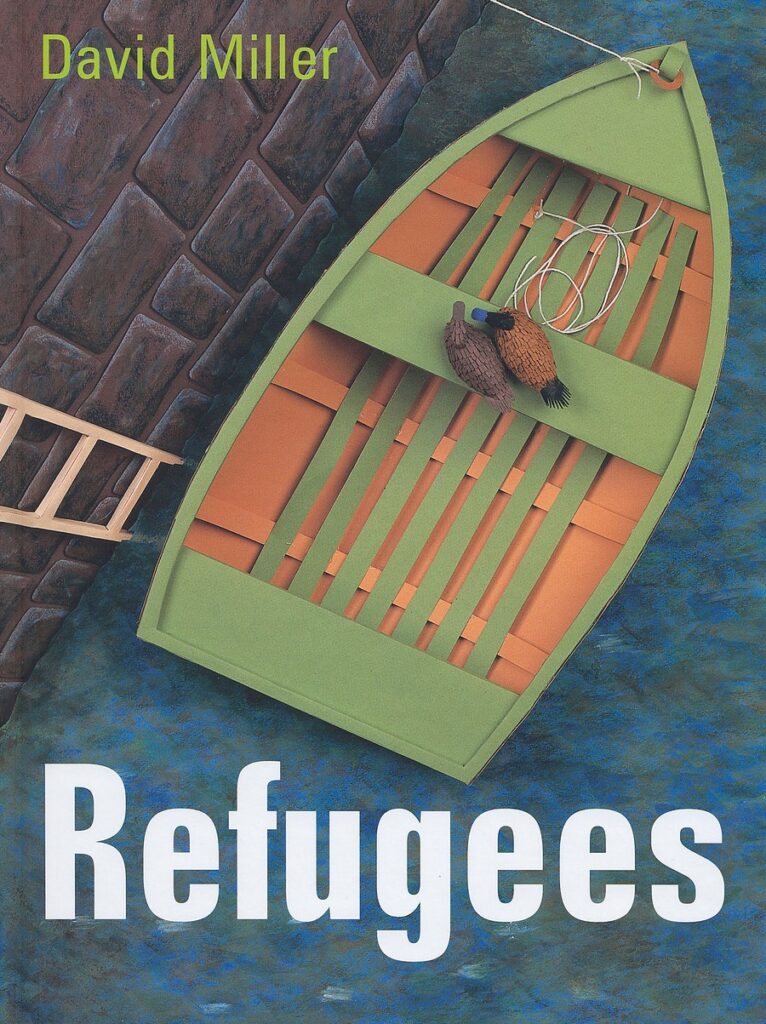
Refugees by David Miller is the story of two wild ducks who have been displaced after their sparkling swamp is drained of water. With their home now destroyed, they are forced to leave the place that for years was safe, secure and sustained them with rich sources of food. Finding a new home proves to be no easy feat. Their long troubled journey to find a safe place to live is fraught with difficulty, danger, rejection, obstacles, life threatening situations and being detained. They unsuccessfully attempt to relocate to several different homes before they are given a new home.
The illustrations are a sight to behold. They are gloriously vibrant and are three dimensional paper sculptures. These have been created by cutting, folding and securing in place countless pieces of coloured paper on different coloured backgrounds. The level of detail is extraordinary. The paper is cut meticulously to create stunning and intricate detail and textures, such as individual feathers, leaves, swamp reeds and even fur on a dog. The illustrations enrich the narrative providing further insight into just how vulnerable the ducks are. Children and adults alike will delight in the astonishing illustrations which offer something new to discover each time this book is revisited.
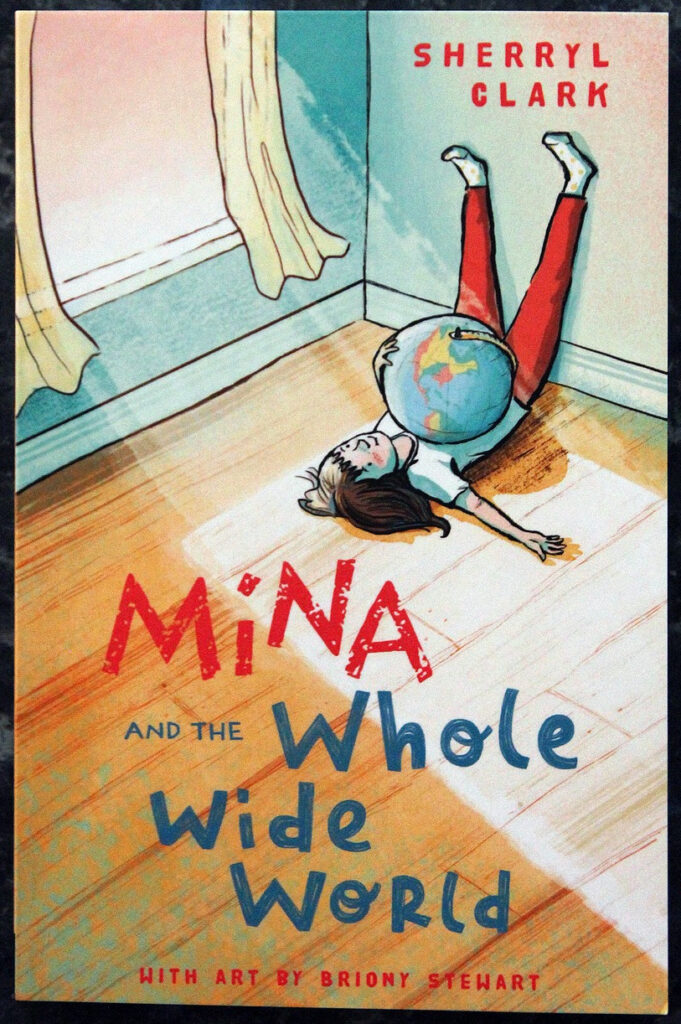
Mina and the Whole Wide World by Sherryl Clark and published by University of Queensland Press (UQP) is a powerful verse novel that draws you into Mina’s world right from the very start. Mina shares a room with her little brother, Georgie, “he’s a wrecker”, so Mina is desperately looking forward to moving into her very own room where she can unpack her box of precious things and then she will no longer need to hide this box of treasure from Georgie. Mina’s room is almost ready; one more coat of paint and then it is all hers. When her dream of owning her own room is nearly realised, Mina’s parents tell her that someone is coming to live with them for a little while and they will need Mina’s room. Mina is shattered and is devoid of words as the reality of this sinks in. Mina feels voiceless as she feels robbed of what was hers and the devastation as well as an enormous sense of loss causes her to withdraw and not speak. This person who is coming to stay is Azzami, he is a refugee.
A detailed review has been written in an earlier Reading Opens Doors blog post here
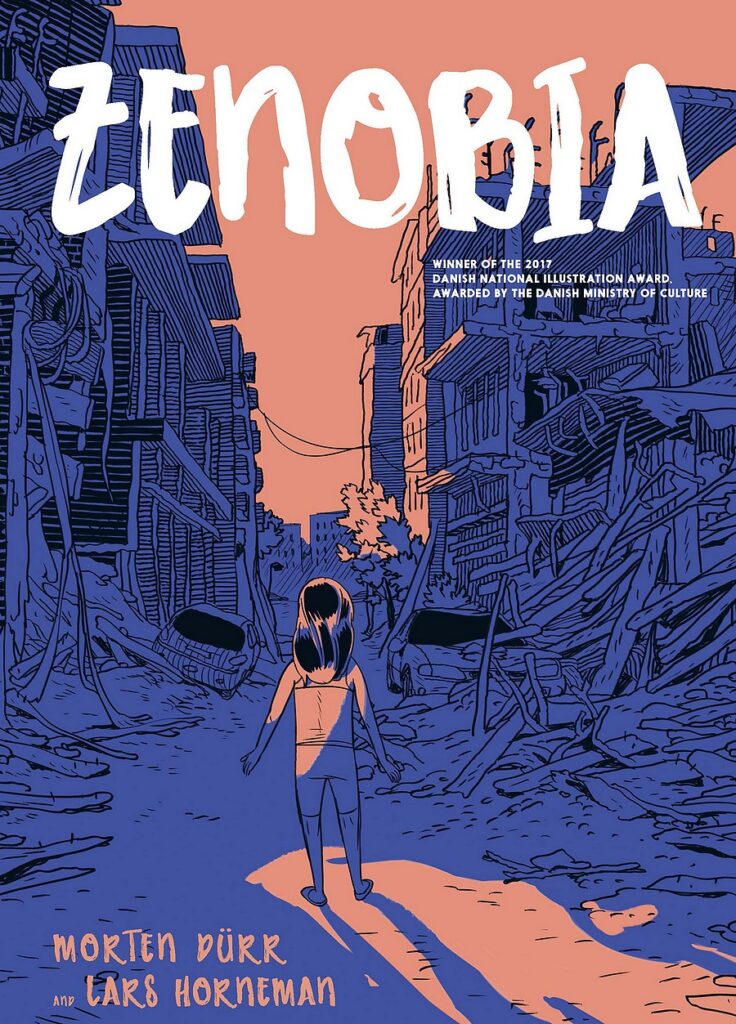
Zenobia by Morten Dürr, illustrated by Lars Horneman and published by University of Queensland Press (UQP) is a graphic novel my younger daughter is currently reading. This powerful, visually driven story, with very few words tells the story graphically in panels of Amina. This book highlights the beyond devastating loss and enormous tragedy the victims of war suffer and deftly reveals the harrowing circumstances faced in an attempt to seek refuge. Amina flees her war-torn homeland in Syria. She boards an overcrowded boat filled with refugees. During the treacherous journey a storm wreaks havoc and flings Amina overboard into the ocean. As she plunges further down into the sea memories from home and her childhood flood her mind. She takes comfort from stories her mother had told her about Zenobia, an ancient Syrian queen. This book is suited to students in upper primary school. Please be aware that the ending is confronting so as always, consider the experiences and personal history of children to determine suitability for your readers. Lars Horneman uses three distinct colour palettes to distinguish the present, past and flash back scenes. A natural colour palette is used for the present, a brown and yellow colour scheme is used for the past, this colour combination is synonymous with aged photos and pink and blue is used for the flashbacks during Queen Zenobia’s rule.
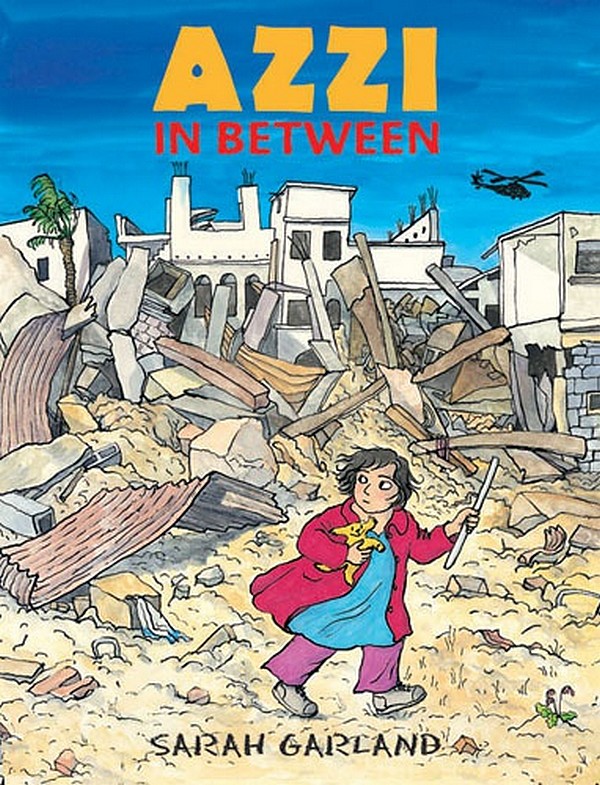
Azzi in Between by Sarah Garland is a graphic novel for younger readers around 7+ about a young girl and her family who have been displaced due to war and the challenges and obstacles they overcome in their new country. This story begins with Azzi, a young girl who is living in a country at war (the country is not specified). At first life carries on as “normal” despite evidence of war. One evening her father receives a phone call that irrevocably changes their lives. He instructs the family that they must leave at once as their lives are in danger. Azzi’s grandmother stays “to look after the house”. Once they reach their destination Azzi and her parents run with other people to board a boat. Many people are attempting to get onto this boat, all too aware that not everyone is going to be able to do so, people are jostling for their spot. Azzi and her family jump onto the overcrowded boat. This rickety boat sails for days and nights until Azzi sees land.
In this new country the overwhelming feeling of difference is apparent. The food is different, the language is different and their new home is different. Azzi desperately misses her Grandma. Azzi’s parents busy themselves setting up their new diminutive home and are grateful for the few possessions they have been given. Azzi’s mother soon finds a school for her daughter. The first day of school amplifies further differences. The other students wear different clothes to Azzi and the school is so much noisier than her school back home. Thankfully, it isn’t long before Sabeen, an adult, introduces herself to Azzi in a language Azzi is familiar with. Sabeen helps Azzi with her school work, interprets what her teacher is saying and teaches Azzi some words.
Azzi also speaks to Sabeen in class and through her paintings tells Sabeen more about the war her family fled from. Sabeen is compassionate and tells Azzi about her experience of leaving her country when she was six. As each day passes at school Azzi learns more words and so does her family.
A gardening lesson at school becomes a turning point for Azzi as she skilfully prepares the garden, just as her grandmother had taught her, to grow some beans. These were her father’s beans that he had brought from their homeland to their new country. Her teacher and Sabeen are impressed at the new skill Azzi is teaching her class.
Azzi’s heart is full, knowing she has a surprise for her parents – her beans growing in the school garden. Azzi’s mum also has a surprise, her adored Grandma is reunited with them. She shares her dangerous journey from their former home to this new place – where they are together and safe.
After many weeks, Azzi’s family is given approval to stay and her father is now eligible to work. With this comes a move to a slighter larger home.
Each day Azzi feels less different and enjoys more friendships. Azzi is able to teach a new boy from another country English. She hears more of her Grandma’s stories and the beans she planted are thriving. Azzi is able to surprise her father with some of the beans. He is thrilled and plans to plant some beans next spring.
Azzi’s emotional journey and feelings of loss are evident in the pictures through her body language and facial gestures. This is ultimately a positive and hopeful story of a refugee family who overcome many obstacles as they begin a life in a new country.
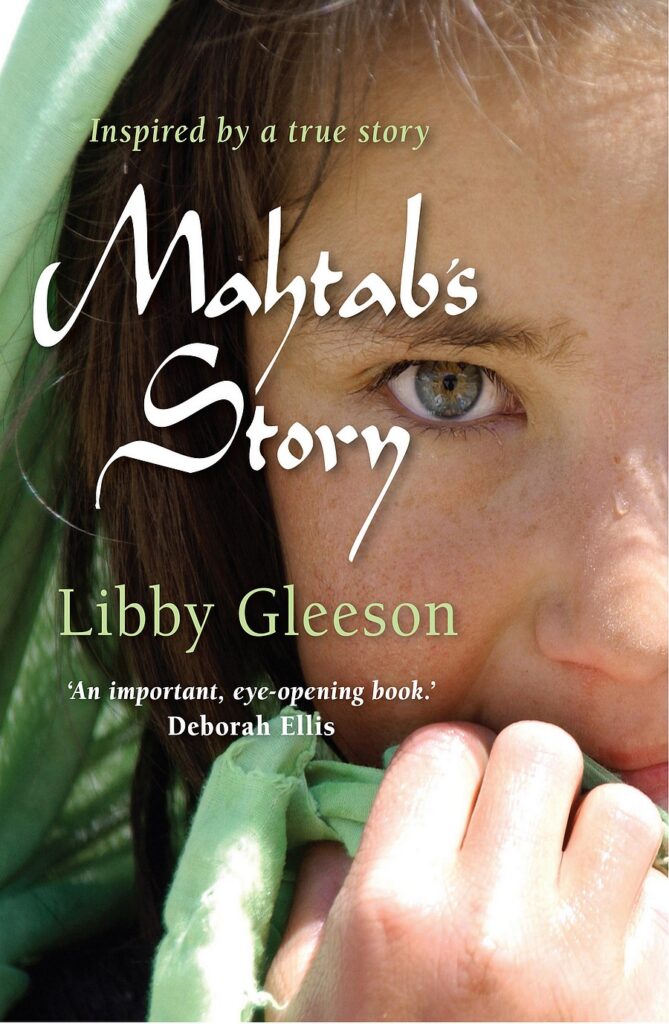
Mahtab’s Story by Libby Gleeson is a story I was reacquainted with while looking for refugee books inspired by a true story to purchase for our family. I have purchased this and it has not arrived yet. This story was inspired by a collection of true stories after Libby Gleeson met a group of female students in a western Sydney school who were all from refugee families. One of the girls was Nahid who was instrumental in helping Libby write this story. Nahid had counteless conversations and illustrated for Libby her personal experiences. From this Libby created a fictional family, however all of the events that occur in the book did happen to either Nahid and her family, or the students Libby spoke with or to someone they knew. This story is told by Mahtab, a twelve year old girl whose family flees Afghanistan and travels to Australia.
A detailed review and reflection of this book will be added here as soon as I have read it.
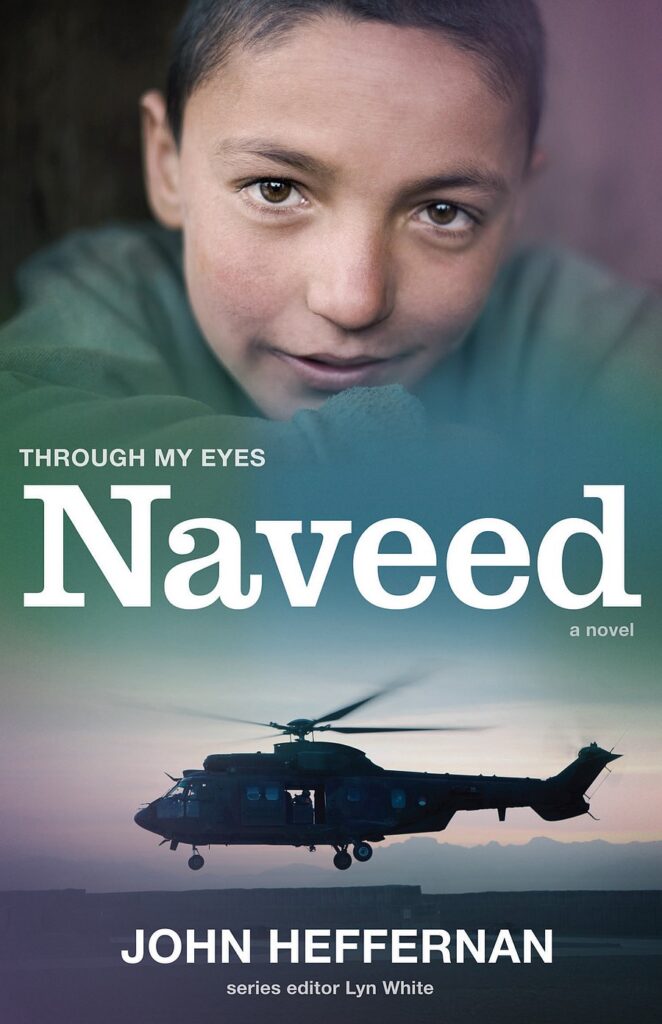
Naveed: Through My Eyes by John Heffernan and edited by Lyn White published by Allen and Unwin is a story I am currently reading with my daughter and this book deserves to be added to this collection. It is a fictional story about strength, struggle, strong family values, the power of family, the beauty in friendship and Afghanistan’s culture. Naveed is a young boy from Afghanistan who lives with his mother and sister, Anoosheh. His sister was involved in a landmine accident causing both of her legs to be amputated. His father was killed by a suicide bomber and Naveed has the enormous responsibility to look after his family and earn money. A more detailed review for this book will be added when we have finished reading it.
